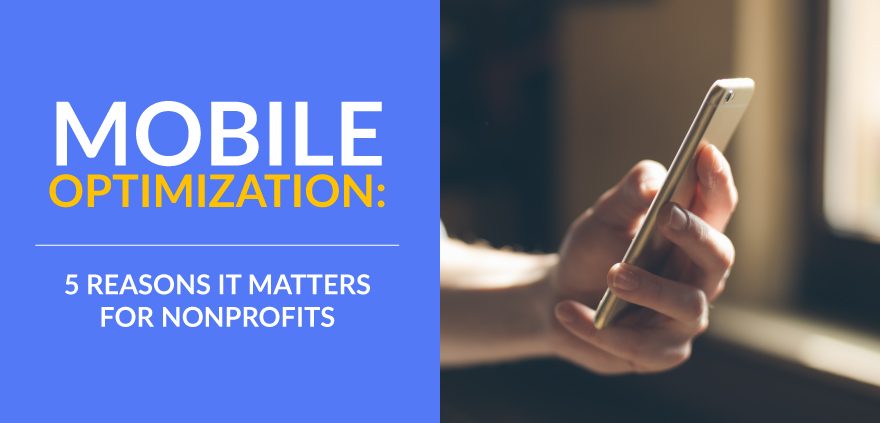Mobile Optimization: 5 Reasons it Matters for Nonprofits
You’ve heard it time and time again: optimizing your website for mobile devices is crucial. Your website goals probably include engaging with donors, volunteers, and other supporters, and encouraging them to stay involved for the long term. A mobile-optimized website can support these goals and help you drive more online traffic.
Specifically, we’re going to discuss five reasons why mobile optimization is so important for nonprofit websites:
- Most people spend a large portion of their day on their phones.
- Mobile donations are more popular than ever.
- Social media use is also increasing globally.
- Mobile optimization is a Google ranking factor.
- Mobile load speed affects bounce rate.
The best nonprofit websites engage and excite supporters whether they’re using their laptops, tablets, or phones to connect. Let’s take a closer look at why you should emphasize mobile-friendliness when designing your website.
1. Most people spend a large portion of their day on their phones.
Research shows that the average smartphone user spends five to six hours per day on their phone. People use their phones for everything from online shopping to binge-watching TV shows, messaging loved ones, and ordering food.
Therefore, your nonprofit’s supporters expect to be able to connect with your organization using their mobile devices. The first step to keeping donors close is appealing to their preferences by offering them a way to engage with and learn more about your nonprofit from the palm of their hand.
2. Mobile donations are more popular than ever.
Supporters want to be able to give any time, anywhere, without having to pull out their laptops to do so. To attract and retain donors, you must offer plenty of convenient, simple donation opportunities, including a mobile-responsive giving page and text-to-give options. Your supporters should be able to easily fill out and move through the donation process on their phones without squinting or having to pinch their screens and zoom in.
3. Social media use is also increasing globally.
Creating mobile-friendly marketing content is also critical for increasing engagement with your social media campaigns. 78% of social media users worldwide only use their mobile devices to access social media platforms. Plus, 55% of people who engage with nonprofits on social media eventually take some sort of action, whether that’s contributing monetary or in-kind donations, volunteering, participating in advocacy campaigns, or attending events.
Developing social media campaigns that look great on mobile devices, with elements such as vertical videos and mobile-friendly landing pages, should be a priority for your organization.
4. Mobile optimization is a Google ranking factor.
Since 2015, Google has used mobile-friendliness as an SEO ranking factor. That means that to improve your site’s chances of ranking higher on search engine results pages, you must ensure it’s mobile-optimized.
To create a mobile-optimized website that ranks highly on Google, keep the formatting and design simple, ensure your text sizes are large enough to be read on mobile devices, and review and edit your site in the mobile view to check for any formatting issues. When you combine these efforts with other SEO best practices, such as optimizing your website’s pages for relevant keywords, you can help your content become more visible on Google and drive more traffic.
5. Mobile load speed affects bounce rate.
A mobile-optimized website is not only crucial for SEO—it’s also a central element in creating a better visitor experience. That’s because visitors expect a streamlined, fast-loading mobile website experience. In fact, 53% of visitors will leave your website if your mobile pages take more than three seconds to load.
If you’re planning to reformat your website’s mobile version, keep web design best practices in mind. Decrease load times by resizing and compressing images, leveraging browser caching, and eliminating unnecessary characters and spaces from your code.
If you’re running into any roadblocks when trying to create a mobile-optimized website, reach out to a nonprofit web design firm for support. These experts can help you carry out audience research and develop a website revamp strategy with your organization’s unique branding and goals in mind.
Whether you tackle your website design in-house or with the help of an experienced professional, these five reasons make it clear that mobile-friendliness should be a top priority.


